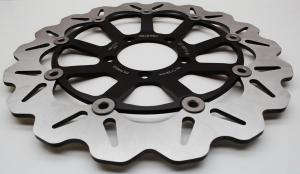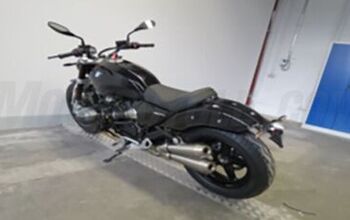Galfer Superbike Wave Rotor Review
While drivers these days seem to be paying more attention to their Blackberry, PDA or GPS than they do to the road, serious motorcycle brakes have never been more important. Come replacement time, you can turn to bike manufacturers for stock components. You can be sure they will fit and get the job done. Sometimes this makes sense. However, other options are available within the aftermarket that can drastically improve the performance of your bike over stock. The choice is yours.
Consider Galfer. While it’s been around for decades, the Spanish firm seemed to appear from semi-obscurity on these shores maybe fifteen years ago. Yet it has risen to become a leader in the stoppage stakes. Mostly, you can credit racing. A peek into the world’s paddocks tells the story. But also, their stuff performs just as well for the street crowd. They’ve offered long-lasting stainless steel brake lines and various pad compounds for years, earning kudos aplenty across the globe. As a perfect example, the test mule for this evaluation, a ’92 ZX-11, has worn the firm’s stainless braided Teflon lines since about 1996.
No surprise, then, that the firm would enter the brake rotor market. Bringing us inescapably, ineluctably to Galfer’s Sport Bike Waves. These stainless steel, laser-cut beauties proved so compelling a design that Kawasaki, among other OEMs, have adopted the design themselves. But unlike Big Green’s “petal” configuration (and of course the ZX-11’s OE discs) these are full-floaters. This means that they’re untroubled by torsional or lateral inconsistencies in the calipers’ movement, or in the brake pistons and pads relative to the rotors. The moving (or floating) pins join the swept area and the alloy carriers, taking up slack in any irregularities. With each stop, all four pads enjoy equal disc contact every time. Goodness exemplified.
The wavy advantages accumulate. It might sound counterintuitive, but the old architectural maxim “less is more” applies here, too. How can cutouts, replacing metal with, well, air, do anything but diminish stopping power? Isn’t the whole idea to have more, not less pad-to-rotor contact? Only if you don’t grasp the basics of heat transfer, and its impact on stopping distance. Thing is, we’re typically dealing with six hundred pounds or more of rider and bike hurtling pell-mell through the ether. In hauling us down, the forces of little brake pads on dinner plate-sized rotors create mammoth heat. (A fact brought memorably home if you touch a rotor after an hour in the twisties.)
Basically, heat degrades braking because it can’t dissipate, no matter the “hardness” or “softness” of the pads’ friction material. On demanding rides, heat leads to glazed pads, leading to increases in lever travel. That puts a “damper” on the day’s shenanigans. We’ve all been there.
Galfer’s Waves are different. Those artful cutouts promote cooling, and longer, safer rides, which is to say, fun. Also, claims Galfer, the asymmetric shape of the holes discourage road crud from hanging around and creating a mess. Another benefit of air where once was metal - decreased rotational mass, i.e., weight. With almost four pounds missing versus the two stock rotors, our ol’ Zixxer is marginally quicker. It also turns in faster, and stand-up in curves seems less, too. The differences may be slight, but they’re real.
The custom-made, patented Waves are made of made of a unique high carbon/stainless steel material. The base sheets are pre-heat treated with a double disc grinded finish to assure parallel and perfect flatness. For the best tolerance, Galfer uses CAD-CAM laser cutting. The rotors’ finishes are surface-ground via a diamond surface finishing system, so each side of the discs are parallel to each other, and perfectly balanced. This leads to harder initial bite, less lever effort and consistent stopping. Interestingly, the rotor blades are slotted top to bottom diagonally and in opposite directions.
Q & A with Galfer
Sandro Milesi, Galfer USA’s representative, had the good grace to endure a few MOronic questions.
MO - Why stainless and not traditional iron?
SM - When Galfer first started to make rotors, the market was experiencing some serious, not-to-be-taken-lightly issues with cast-iron rotors. One manufacturer in particular was constantly having rotors fails due to small cracks that would develop on the rotor’s surface. And if these were not detected the rotor would literally shatter to pieces.
Stainless at that point was in most OE machines but none were using the “fancier,” most expensive stainless materials - just the cheap stuff. When we started to play with stainless, we realized that getting the best material was not going to be enough - we wanted a lot of orders, and our long-term vision dictated that our material be made to our specific CAD-CAM characteristics. That would allow us to get a material that would have great memory retention, and also a material that would allow us to play with feel and brake torque.
All we wanted was at least to get something similar to cast iron, but with out its dangers. After a few years of testing and lots of learning outside of the brake industry, we found the material composition we are using today.
MO – What’s the advantage of full-floating rotors?
SM - Full floating rotors allow for the rotor/friction blade to “chase” the pad’s most efficient contact surface. That means if the caliper or pad was to be a bit off to the right or the left, the floating activity of the rotor blade would account for and “correct” the offset tolerances. When the rotor and the caliper float, that is clearly the best advantage since it allows for perfect surface-to-surface mating conditions.
A stock rotor is referred to as semi-floating. The blade or friction area does move a bit, but very little. What they do have is separation of heat transfer, but that friction blade gets very hot, and during that process it also changes shape becoming almost flexible or elastic, when the two parts (rotor blade and carrier) are separated the heat does not get transferred to the carrier, that is a good thing as you can imagine.
MO – The precision CAD-CAM design work is understandable, but why the laser-cutting technique?
SM - The whole idea behind laser cutting is for us not to warp the rotor or “punch it” during the manufacturing process. Many companies stamp their rotors. We believe that the less stress we give the rotors during the manufacturing process, the better flatness and parallelism the rotor will have.
MO - Any disadvantage of stainless versus other materials?
SM - We have only had complaints in regards to the fact that some of our applications will slightly rust on the friction area. That is because of the carbon composition on these units; otherwise, I really think from a brake standpoint no disadvantages.
MO - Do Waves last as long as stockers given the same pads?
SM - A rotor does not last longer or less than another rotor because of the Wave design or not. It is the manufacturer that can control in their process how long a rotor will or will not last.
MO - The weight reduction from the OE disks is almost four pounds. How much is weight a consideration by your reckoning?
SM - We do not keep track, since our goal is not weight loss but performance. In some cases we have been told we have lost about 1 to 2 pounds or more and in some other cases no weight loss... We think more in terms of brake temperature, performance and shorter braking distances.
MO – Ditto! So Galfer did and does the lines and pads, and now makes the discs. Anything more coming, like calipers or master cylinders?
SM – We will have calipers for the 2009 race season.
As for pads, I’d already accumulated a few hundred miles on Galfer’s 1375HHs before warpage spelled an end to the big Zixxer’s OE discs. They’d performed admirably in that context, and easily transitioned to the Waves, using the OE Tokiko calipers. The HH compound, like the discs, is claimed to perform as well for sporty street riding as for racing applications and track days. They’re ceramic-based with a ceramic-coated backing plate. That, Galfer USA representative Sandro Milesi told us, “reduces the amount of heat transfer from pad to caliper.” As well as reducing the glazing that super-heated pads acquire when a bike’s being thrashed. Also, using special ceramics means rotors wear less and last longer than copper-based pads, Milesi asserts.
Mind you, matching discs to pads is no small consideration. Galfer’s R&D department “has gone as far as to junk a new prototype of stainless compound for rotors because it did not match the performance in testing that we had already as a bench mark at that point.” Milesi concludes, “Our pad compounds as well as our choice of rotor material specifications are carefully chosen and tested to deliver the best braking performance together.”
Mated to the “unique rotor material … these pads should deliver lots of initial bite, good on and off modulation, and excellent heat resistance.” So said, so done. On our test mule, the combo would be hard-pressed. I weigh 200 lbs., and the bike about 560 wet. In a little less than a thousand miles, we strafed serpentines, straightened sweepers fast and slow, avoided tire carcasses and other rubbish, and managed to stay upright in the wet. All the while, of course, I was flogging the brakes in all these conditions and there were no trouser-filling panic stops. But the Waves, in a few high-speed tests simulating same, passed without drama. We sampled the gamut of road types - super slab, English-style country lanes, off-camber, decreasing-radius parkland roads. Happily, whether in urban madhouse or suburban sprawl, the Wave and pad combination proved equal to the task.
Bottom line? I can’t vouch for Galfer’s claimed thirty percent greater braking power. That wouldn’t be prudent. Nonetheless, with the Waves, the 1375-HH compound pads and the aforementioned braided Teflon lines, my backside decelerometer calculates a definite improvement over the previous brakes. Along with the small advantage of quicker handling the very large improvements are the consistency and virtual lack of fading – even in hard riding. Doug Chandler describes his impressions of the race version of the Waves by saying, “They deliver more bite and consistency than anything I’ve tried with much less brake lever effort.”
I wish I’d had an entire riding season to put the Waves through their paces. Even with just shy of 1,000 miles, however, it’s perfectly clear what we have is an extremely competent design reflecting much thought, lessons learned, R&D excellence and engineering care.
More by David Walsh
































Comments
Join the conversation